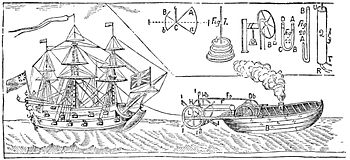An account of his experiment is to be found in manuscript in the correspondence between Leibnitz and Papin, preserved in the Royal Library at Hanover.
78. December 21, 1736, Jonathan Hulls took out an English patent for the use of a steam-engine for ship-propulsion, proposing to employ his steamboat in towing.
In 1737 he published a well-written pamphlet[1] describing this apparatus, an engraving of which is here shown in fac-simile.

Fig. 45.—Hulls's Steam Towboat, 1787.
He proposed using the Newcomen engine, fitted with a counterpoise weight, and a system of ropes and grooved wheels, which, by a peculiar ratchet-like action, gave a continuous rotary motion.
There is no positive evidence that Hulls ever put his scheme to the test of experiment, although tradition does say that he made a model, which he tried with such ill success as to prevent his further prosecution of the experiment. Doggerel rhymes are still extant which were, it is said, sung by his neighbors in derision of his folly, as they considered it.
79. William Henry, of Chester County, Pennsylvania, is said to have constructed a model steamboat in 1763. It was a failure, although not a discouraging one.
80. In 1774 the Comte d'Auxiron, a French nobleman, and a gentleman of some scientific attainments, constructed a steamboat, and tried it on the Seine, with the aid of M. Perier.
This experiment proving unsuccessful, M. Perier built another boat, which he tried independently in 1775, but was again unsuccessful, owing principally to the small power of his engine.
81. In 1778, and again in 1781 or 1782, the French Marquis de Jouffroy, who, in his later experiments, used quite a large vessel, succeeded in obtaining such good results as to encourage him to persevere, but, political disturbances driving him from his country, his labors terminated abruptly.
- ↑ "A Description and Draught of a Newly-invented Machine for carrying Vessels or Ships out of or into any Harbor, Port, or River, against Wind and Tide, and in a Calm," London, 1737.
